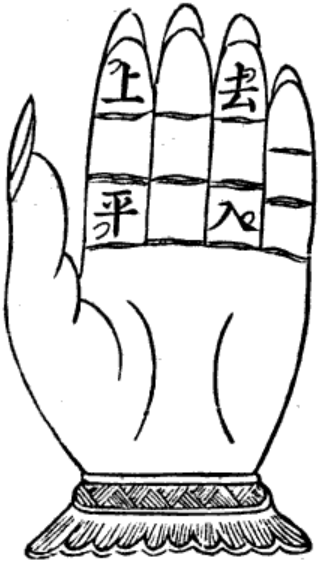Tone is the use of pitch in language to distinguish lexical or grammatical meaning—that is, to distinguish or to inflect words. All oral languages use pitch to express emotional and other para-linguistic information and to convey emphasis, contrast and other such features in what is called intonation, but not all languages use tones to distinguish words or their inflections, analogously to consonants and vowels. Languages that have this feature are called tonal languages; the distinctive tone patterns of such a language are sometimes called tonemes, by analogy with phoneme. Tonal languages are common in East and Southeast Asia, Africa, the Americas and the Pacific.
A syllable is a unit of organization for a sequence of speech sounds, typically made up of a syllable nucleus with optional initial and final margins. Syllables are often considered the phonological "building blocks" of words. They can influence the rhythm of a language, its prosody, its poetic metre and its stress patterns. Speech can usually be divided up into a whole number of syllables: for example, the word ignite is made of two syllables: ig and nite.
Sandhi is a cover term for a wide variety of sound changes that occur at morpheme or word boundaries. Examples include fusion of sounds across word boundaries and the alteration of one sound depending on nearby sounds or the grammatical function of the adjacent words. Sandhi belongs to morphophonology.
Tone sandhi is a phonological change that occurs in tonal languages. It involves changes to the tones assigned to individual words or morphemes, based on the pronunciation of adjacent words or morphemes. This change typically simplifies a bidirectional tone into a one-directional tone. Tone sandhi is a type of sandhi, which refers to fusional changes, and is derived from the Sanskrit word for "joining."

Middle Chinese or the Qieyun system (QYS) is the historical variety of Chinese recorded in the Qieyun, a rime dictionary first published in 601 and followed by several revised and expanded editions. The Swedish linguist Bernhard Karlgren believed that the dictionary recorded a speech standard of the capital Chang'an of the Sui and Tang dynasties. However, based on the preface of the Qieyun, most scholars now believe that it records a compromise between northern and southern reading and poetic traditions from the late Northern and Southern dynasties period. This composite system contains important information for the reconstruction of the preceding system of Old Chinese phonology.

The Linguistic Society of Hong Kong Cantonese Romanization Scheme, also known as Jyutping, is a romanisation system for Cantonese developed in 1993 by the Linguistic Society of Hong Kong (LSHK).
Historical Chinese phonology deals with reconstructing the sounds of Chinese from the past. As Chinese is written with logographic characters, not alphabetic or syllabary, the methods employed in Historical Chinese phonology differ considerably from those employed in, for example, Indo-European linguistics; reconstruction is more difficult because, unlike Indo-European languages, no phonetic spellings were used.

Jin is a proposed group of varieties of Chinese spoken by roughly 48 million people in northern China, including most of Shanxi province, much of central Inner Mongolia, and adjoining areas in Hebei, Henan, and Shaanxi provinces. The status of Jin is disputed among linguists; some prefer to include it within Mandarin, but others set it apart as a closely related, but separate sister-group.
General Chinese is a diaphonemic orthography invented by Yuen Ren Chao to represent the pronunciations of all major varieties of Chinese simultaneously. It is "the most complete genuine Chinese diasystem yet published". It can also be used for the Korean, Japanese, and Vietnamese pronunciations of Chinese characters, and challenges the claim that Chinese characters are required for interdialectal communication in written Chinese.

The Fuzhou language, also Foochow, Hokchew, Hok-chiu, or Fuzhounese, is the prestige variety of the Eastern Min branch of Min Chinese spoken mainly in the Mindong region of Eastern Fujian Province. As it is mutually unintelligible to neighbouring varieties in the province, under a technical linguistic definition Fuzhou is a language and not a dialect. Thus, while Fuzhou may be commonly referred to as a 'dialect' by laypersons, this is colloquial usage and not recognised in academic linguistics. Like many other varieties of Chinese, the Fuzhou dialect is dominated by monosyllabic morphemes that carry lexical tones, and has a mainly analytic syntax. While the Eastern Min branch it belongs to is relatively closer to other branches of Min such as Southern Min or Pu-Xian Min than to other Sinitic branches such as Mandarin, Wu Chinese or Hakka, they are still not mutually intelligible.
Wong Shik Ling published a scheme of phonetic symbols for Cantonese based on the International Phonetic Alphabet (IPA) in the book A Chinese Syllabary Pronounced According to the Dialect of Canton. The scheme has been widely used in Chinese dictionaries published in Hong Kong. The scheme, known as S. L. Wong system (黃錫凌式), is a broad phonemic transcription system based on IPA and its analysis of Cantonese phonemes is grounded in the theories of Y. R. Chao.
Tone numbers are numerical digits used like letters to mark the tones of a language. The number is usually placed after a romanized syllable. Tone numbers are defined for a particular language, so they have little meaning between languages.
The phonology of Burmese is fairly typical of a Southeast Asian language, involving phonemic tone or register, a contrast between major and minor syllables, and strict limitations on consonant clusters.
Standard Cantonese pronunciation is that of Guangzhou, also known as Canton, capital of Guangdong Province. Hong Kong Cantonese is related to Guangzhou dialect, and they diverge only slightly. Yue dialects in other parts of Guangdong and Guangxi provinces like Taishanese, may be considered divergent to a greater degree.

The four tones of Chinese poetry and dialectology are four traditional tone classes of Chinese words. They play an important role in Chinese poetry and in comparative studies of tonal development in the modern varieties of Chinese, both in traditional Chinese and in Western linguistics. They correspond to the phonology of Middle Chinese, and are named even or level, rising, departing or going, and entering or checked. They are reconstructed as mid, mid rising, high falling, and mid with a final stop consonant respectively. Due to historic splits and mergers, none of the modern varieties of Chinese have the exact four tones of Middle Chinese, but they are noted in rhyming dictionaries.
The Fuqing dialect, or Hokchia, is an Eastern Min dialect. It is spoken in the county-level city of Fuqing, China, situated within the prefecture-level city of Fuzhou. It is not completely mutually intelligible with the Fuzhou dialect, although the level of understanding is high enough to be considered so.
Old Mandarin or Early Mandarin was the speech of northern China during the Jurchen-ruled Jin dynasty and the Mongol-led Yuan dynasty. New genres of vernacular literature were based on this language, including verse, drama and story forms, such as the qu and sanqu.
The Meixian dialect, also known as Moiyan dialect, as well as Meizhou dialect (梅州話), or Jiaying dialect and Sixian dialect, is the prestige dialect of Hakka Chinese. It is named after Meixian District, Guangdong.
Shaxian dialect is a dialect of Central Min Chinese spoken in Sha County, Sanming in Western Fujian Province of China.
Northern Wu, or Taihu Wu, is the largest subbranch of Wu Chinese, and is spoken in Shanghai, southern Jiangsu, and northern Zhejiang. These languages are noted for their extremely high number of vowels, even compared to some Germanic languages, and highly complex tone sandhi. This article will use Wugniu and IPA for transcription.




